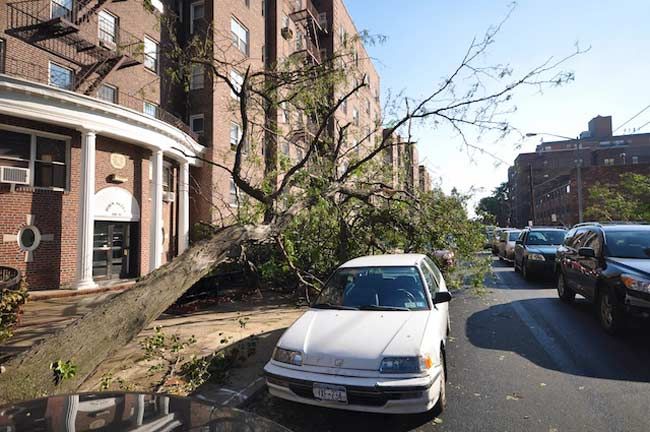
Tornado in NYC? Experts Survey Damage

Reconstructing a possible tornado strike last night in the New York City area may resemble more of a crime scene investigation than a storm-chaser sequence.
A group of meteorologists set out today (Sept. 17) to survey the aftermath of the storm that killed one person and toppled trees onto cars in Staten Island, Brooklyn, Queens and areas of New Jersey. They plan to have a report before the end of the day.
By examining the evidence on the ground and interviewing witnesses, they hope to figure out if a tornado did indeed leave its mark. [See images of damage in Queens.]
"They're going to be looking at any damage in the area to get an idea of what happened and reconstruct the path of the storm," said Sean Potter, a communications specialist with the National Weather Service in New York City.
The Queens Botanical Garden alone reported at least 15 downed trees, and damage spread across 39 acres (16 hectares) in the Flushing area of Queens.
New York City does not get the high frequency of tornadoes that spawn in the Midwest and Great Plains, Potter said. But "it's not unheard of," he added.
Warning signs
Sign up for the Live Science daily newsletter now
Get the world’s most fascinating discoveries delivered straight to your inbox.
Doppler radar had shown the possibility of tornadoes spawning from a severe thunderstorm near Tottenville, Staten Island, and Perth Amboy, N.J., in the late afternoon.
A tornado warning came soon after from one of the many ground spotters trained by the National Weather Service.
"We got report of a funnel cloud from a trained spotter on Staten Island," Potter told LiveScience.
Just how many tornadoes might have made an appearance last night remains unclear. Investigators plan to look for specific criteria to figure out whether a tornado or just strong winds wreaked havoc on the outer boroughs of the city.
"For example, if a roof was damaged or torn off a building, they'll see how much was torn off," Potter said. "They'll take into account the structure of the building, how well it was constructed, and what materials it was made of to get insight into how strong the winds were."
The rotational patterns of tornados can also leave signature damage in wheat fields or corn fields – but the New York survey team likely won't find that type of evidence.
A history of weather violence
Yesterday's storm would not represent the first time tornados have touched New York City this year, if confirmed.
One tornado struck nearby Bridgeport, Conn., on June 24, and another touched down in the Bronx on July 25. The latter represented just the second tornado to strike the Bronx since 1950.
Both tornadoes represented some of the weaker types of tornadoes, rated EF1, which can still have wind gusts of 86 to 109 mph (138 to 175 kph). Only EF0 has slower wind speeds.
The strongest tornadoes ever to strike New York City took place on Aug.8, 2007. Several touched down along a 9-mile (14.5-kilometer) path from Staten Island to Brooklyn in the early morning hours.
New York City and other Northeast cities typically don't get supercell thunderstorms that can produce vicious twisters in states such as Texas and Oklahoma, Potter explained.
"But even a weak tornado in an urban area can cause significant damage and is something that should not be taken lightly," Potter said.
Shelter from the storm
A YouTube video that shows several Brooklyn residents rhapsodizing over a possible tornado from last night has already begun circulating online.
But their behavior includes just about everything a person does not want to do in an actual tornado situation, including hovering by an open door and near windows on one of the upper floors of a building.
The National Weather Service recommends that urban residents in high-rise buildings should make their way to the lowest part of the building, if a basement is not available. People should also find an interior hallway or room with no windows such as a closet, and use blankets and pillows to shield their body.












